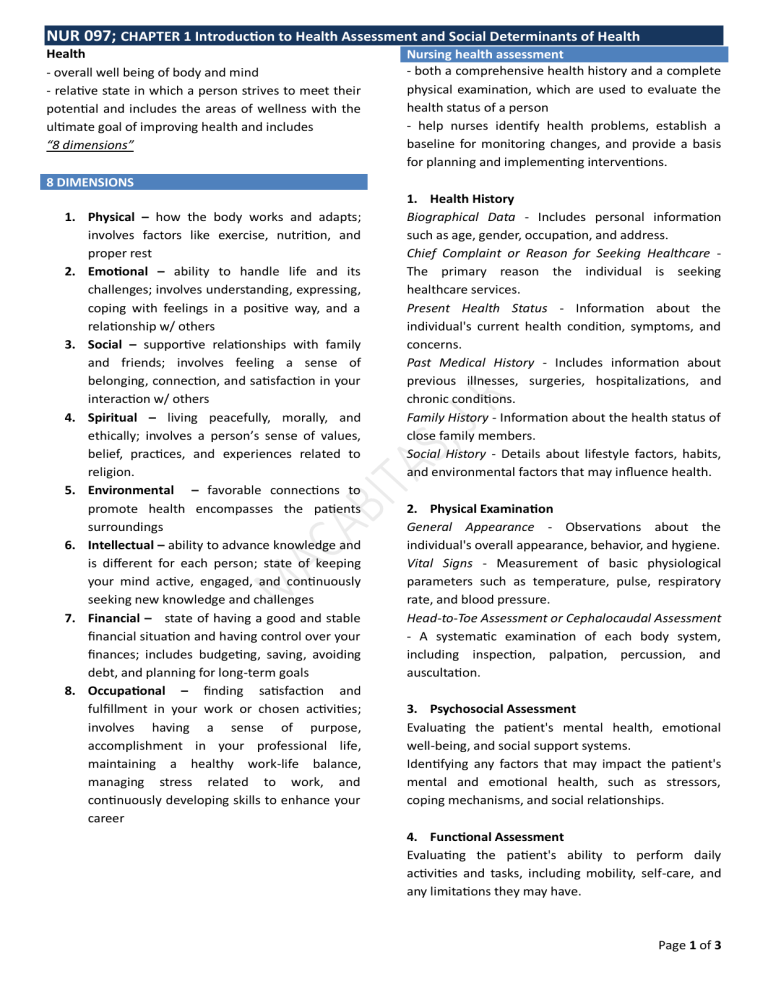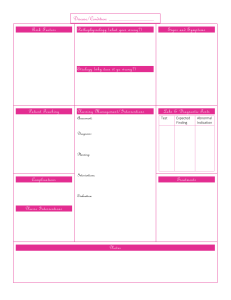NUR 097 - 098; CHAPTER 1 Introduction to Health Assessment and Social Determinants of Health
advertisement

NUR 097; CHAPTER 1 Introduction to Health Assessment and Social Determinants of Health Health - overall well being of body and mind - relative state in which a person strives to meet their potential and includes the areas of wellness with the ultimate goal of improving health and includes “8 dimensions” Nursing health assessment - both a comprehensive health history and a complete physical examination, which are used to evaluate the health status of a person - help nurses identify health problems, establish a baseline for monitoring changes, and provide a basis for planning and implementing interventions. 8 DIMENSIONS 1. Physical – how the body works and adapts; involves factors like exercise, nutrition, and proper rest 2. Emotional – ability to handle life and its challenges; involves understanding, expressing, coping with feelings in a positive way, and a relationship w/ others 3. Social – supportive relationships with family and friends; involves feeling a sense of belonging, connection, and satisfaction in your interaction w/ others 4. Spiritual – living peacefully, morally, and ethically; involves a person’s sense of values, belief, practices, and experiences related to religion. 5. Environmental – favorable connections to promote health encompasses the patients surroundings 6. Intellectual – ability to advance knowledge and is different for each person; state of keeping your mind active, engaged, and continuously seeking new knowledge and challenges 7. Financial – state of having a good and stable financial situation and having control over your finances; includes budgeting, saving, avoiding debt, and planning for long-term goals 8. Occupational – finding satisfaction and fulfillment in your work or chosen activities; involves having a sense of purpose, accomplishment in your professional life, maintaining a healthy work-life balance, managing stress related to work, and continuously developing skills to enhance your career 1. Health History Biographical Data - Includes personal information such as age, gender, occupation, and address. Chief Complaint or Reason for Seeking Healthcare The primary reason the individual is seeking healthcare services. Present Health Status - Information about the individual's current health condition, symptoms, and concerns. Past Medical History - Includes information about previous illnesses, surgeries, hospitalizations, and chronic conditions. Family History - Information about the health status of close family members. Social History - Details about lifestyle factors, habits, and environmental factors that may influence health. 2. Physical Examination General Appearance - Observations about the individual's overall appearance, behavior, and hygiene. Vital Signs - Measurement of basic physiological parameters such as temperature, pulse, respiratory rate, and blood pressure. Head-to-Toe Assessment or Cephalocaudal Assessment - A systematic examination of each body system, including inspection, palpation, percussion, and auscultation. 3. Psychosocial Assessment Evaluating the patient's mental health, emotional well-being, and social support systems. Identifying any factors that may impact the patient's mental and emotional health, such as stressors, coping mechanisms, and social relationships. 4. Functional Assessment Evaluating the patient's ability to perform daily activities and tasks, including mobility, self-care, and any limitations they may have. Page 1 of 3 NUR 097; CHAPTER 1 Introduction to Health Assessment and Social Determinants of Health 5. Review of Systems (ROS) Inquiry about Symptoms - Systematically examining each body system to identify any signs or symptoms that may be relevant to the patient's overall health. 6. Documentation Recording all assessment findings accurately and comprehensively in the patient's health record. 7. Analysis and Interpretation Synthesizing the collected data to identify patterns, potential health issues, and areas for further investigation. Role of the nurse in assessment Nurses deliver care across the lifespan in a variety of practice arenas small sample of the groups served are pediatrics, geriatrics, medical, surgical, mental health, maternity, and community health Nurses assess patient needs, develop interventions, and educate and counsel individuals, families, groups, and communities toward higher levels of health and wellness Nurses view health as the focus with the patient, the environment, and the nurse all influencing the health status of the patient Assessing the patient by using the eight dimensions is at the forefront of the nurse’s responsibilities The nurse conducts a comprehensive assessment covering physical, mental, emotional, developmental, social, and spiritual dimensions of the patient. Physically - signs like changes in vital signs, nausea, or incontinence are observed. Mentally - alterations in consciousness and confusion may be noted. Emotionally - the nurse explores mood changes, considering factors like abuse or financial worries. Developing rapport allows the nurse to address sensitive issues. Developmentally - guidance may be needed for problem-solving or moral understanding. Socially - the patient may be isolated, and the nurse suggests self-help groups or resources. Spiritually - the patient's preferences interventions, such as connecting with clergy. guide Collaborating with the patient ensures partnership in decision-making - addressing social determinants of health and promoting long-term healthier lifestyle outcomes. NURSING PROCESS - it is used to identify patient problems; set a goal and develop an action plan; implement the plan; and evaluate the outcome NURSING STEPS ARE: Assessment Diagnosis Planning Implementation Evaluation I. Assessment - Gather comprehensive information about the patient's health status through observations, interviews, and examinations. Subjective data – information provided by the patient, often based on their feelings, perceptions, or experiences. Examples: Vital signs (e.g., heart rate, blood pressure), physical examination findings (e.g., skin color, respiratory rate), laboratory results, and diagnostic imaging. Objective data – observable and measurable information that can be assessed using the five senses or through diagnostic tests. II. Diagnosis - Identify health issues and their root causes based on the collected data, leading to the formulation of nursing diagnoses. III. Planning - Develop a tailored care plan by setting priorities, establishing goals, and determining specific nursing interventions. Page 2 of 3 NUR 097; CHAPTER 1 Introduction to Health Assessment and Social Determinants of Health IV. Implementation - Execute the care plan by carrying out nursing interventions, coordinating care, and providing patient education. V. Evaluation - Assess the effectiveness of the care plan by measuring outcomes, comparing them with goals, and making necessary adjustments for ongoing care. TYPES OF HEALTH ASSESSMENT The admission of a new patient to a clinic, hospital, long-term care facility, or visiting nurse agency usually requires a comprehensive health assessment Comprehensive Health Assessment - A thorough examination of a patient's physical, psychological, social, and environmental aspects. -Conducted during initial encounters or periodic check-ups to provide a holistic view of the patient's overall health. Focused or Problem-Oriented Health Assessment - A follow-up history is a form of a focused assessment - Targeted and specific, addressing a particular health concern or set of related issues. - Performed in response to immediate health problems, guiding interventions for the specific identified problem. Emergency history – is a data collection which focused on the patient’s emergent problem with a systematic prioritization of need beginning with the ABCs of airway, breathing, and circulation a) Airway - Assess and clear any obstructions. b) Breathing - Evaluate and provide artificial ventilation if necessary. c) Circulation - Check for signs of circulation and initiate chest compressions if needed. This sequence is a fundamental guideline for prioritizing interventions to address lifethreatening issues promptly. Page 3 of 3




